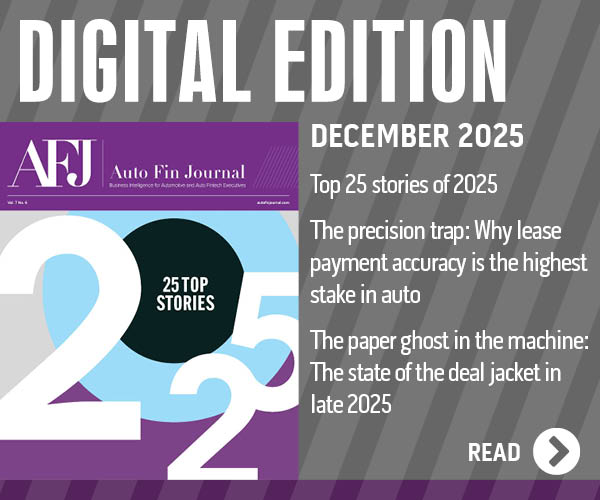Auto finance paces TransUnion’s newest global fraud analysis

By subscribing, you agree to receive communications from Auto Remarketing and our partners in accordance with our Privacy Policy. We may share your information with select partners and sponsors who may contact you about their products and services. You may unsubscribe at any time.
Auto finance is leading the way in a trend that’s likely to give executives and managers plenty of headaches.
A global TransUnion analysis found that fraud continues to significantly impact businesses and their bottom lines.
The newly released H2 2024 Update to the State of Omnichannel Fraud Report, which explores fraud trends in the first half of this year, also showed that the finance company and lender risk exposure to synthetic identities for U.S. auto finance, bank credit cards, retail credit cards and unsecured personal loans reached their highest point ever.
Among the key findings in the report were the results of a TransUnion survey of more than 800 business leaders in Canada, India, the U.K. and the U.S. which revealed total fraud losses of 6.5% equivalent of their companies’ revenue. This totaled approximately $359 billion among these business leaders’ organizations, a number which projects out exponentially greater when considering these represent only a small percentage of business leaders.
Among those surveyed in the U.S., they said their company lost the equivalent of 6.7% of their revenue due to fraud over the past year, totaling $112 billion.
In addition, 75% of the global survey respondents said that every type of fraud they measured stayed the same or increased year-over-year.
Subscribe to Auto Remarketing to stay informed and stay ahead.
By subscribing, you agree to receive communications from Auto Remarketing and our partners in accordance with our Privacy Policy. We may share your information with select partners and sponsors who may contact you about their products and services. You may unsubscribe at any time.
Nearly half of respondents indicated that scam/authorized fraud — wherein a person is tricked into giving up something of value — saw the greatest year-over-year increase.
TransUnion reported it was also the most common cause of fraud loss according to global respondents at 31% and U.S. respondents at 35%. In fact, in the U.S., this was more than double the next most common cause of fraud losses — synthetic identity fraud at 17%.
Furthermore, TransUnion found that exposure to synthetic identities continues to trend upward, led by auto-finance losses topping $2 billion halfway through this year.
“Protecting customers and their businesses from fraud is essential to enabling safe and tailored consumer experiences. These findings reveal that despite the good-faith efforts that are being undertaken by global organizations to identify and prevent fraud to date, fraudsters continue to evolve and it’s vital that fraud prevention methods keep up with the changing times,” said Steve Yin, global head of fraud at TransUnion.
“Business that aren’t already doing so should ensure that they are taking advantage of fraud prevention technologies such as identity verification, IP intelligence, device reputation and synthetic identity detection as critical components of their fraud prevention programs,” Yin continued in a news release.
According to proprietary insights from TransUnion’s global intelligence network, the global rate of suspected digital fraud remained stubbornly high during the first half of 2024 at 5.2% of all transactions.
For transactions where the consumer was located in the U.S., TransUnion determined 4.6% of digital transactions were suspected to be fraudulent over the period.
Breaking it down by the industry, the highest rate of suspected digital fraud for transactions where the consumers were in the U.S. was the gaming sector, for which 13.3% of all transactions in that industry were suspected to be fraudulent in during the first half of the year.
Potentially driven in part by the wealth of stolen identities acquired via data breaches, TransUnion indicated accounts opened using synthetic identities continue to put finance companies and other lenders at risk.
In fact, researchers found that the increases among overall lender exposure to synthetic identities for U.S. auto financing, bank credit cards, retail credit cards and unsecured personal loans continued through the first half of the year.
TransUnion documented such exposure rising from $3.0 billion to $3.2 billion, an all-time high and growth of 7% year-over-year. The share of accounts opened for the four tradelines by synthetic identities rose 18% year-over-year, also reaching an all-time high, according to TransUnion.
As mentioned, TransUnion said the auto-finance industry continued to be the most impacted by exposure to synthetic identities among the four tradelines, accounting for $2.0 billion of the total, the fourth consecutive first half of the year in which auto has seen the greatest exposure.
Furthermore, since surpassing bankcards in 2021, TransUnion said auto exposure is now double that of bankcards, which is currently at $1.0 billion.
“Fraudsters are increasingly using synthetic identities to accumulate balances, particularly targeting the auto industry,” Yin said. “Unfortunately, this warrants attention to as the market is now facing a rising threat of charge-offs.”
TransUnion came to its conclusions about digital fraud based on intelligence from its identity and fraud product suite — TransUnion TruValidate — that can help secure trust across channels and delivers efficient consumer experiences.
The rate or percentage of suspected digital fraud attempts reflect those that TransUnion customers determined met one of the following conditions:
—Denial in real time due to fraudulent indicators
—Denial in real time for corporate policy violations
—Determined to be fraudulent upon customer investigation
—Determined to be a corporate policy violation upon customer investigation compared to all transactions it assessed for fraud
For more information and insights about global fraud trends, download the TransUnion report via this website.


